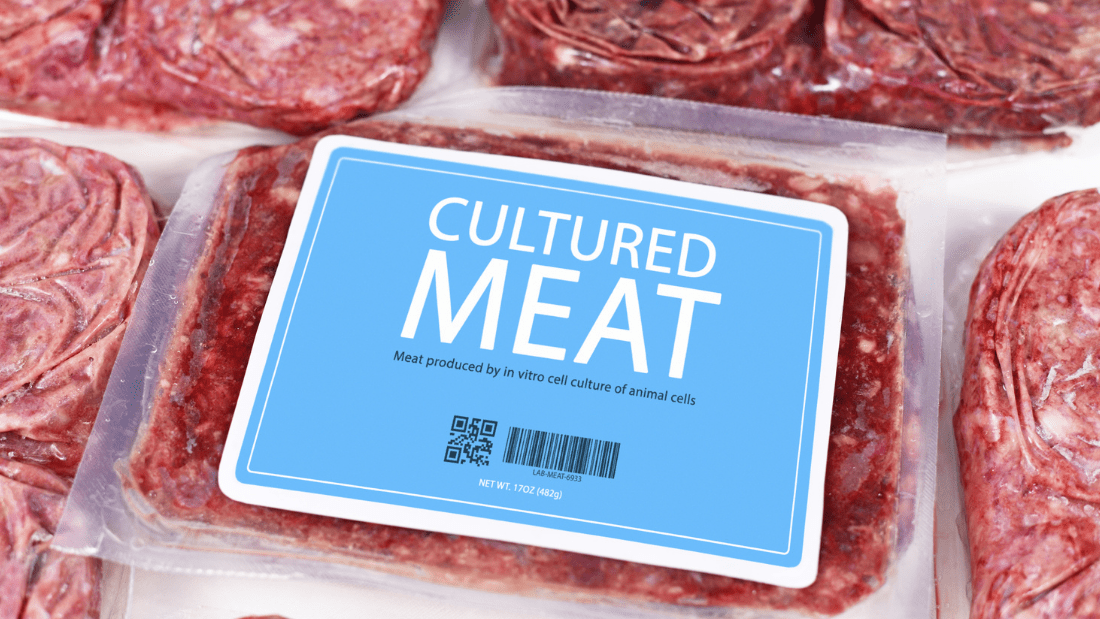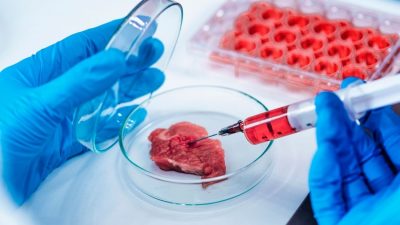Cultured ‘lab’ meat – should vegans support it?

A few years ago, I visited a meat cell-culture laboratory in Holland with Viva! founder and director Juliet Gellatley. Having worked as a molecular biologist, the laboratory environment was familiar to me but as a long-term vegan, and having not eaten meat for almost 40 years, the pink mushy cells growing in a Petri dish may as well have been from another planet!
At first, it looked like science fiction – meat grown in a laboratory. But cultured ‘lab’ meat is now a very real prospect. In December 2020, ‘chicken bites’, produced by the US company Eat Just, passed safety reviews and were launched in a Singapore restaurant retailing at around £13 for a set meal. Eat Just’s chief executive, Josh Tetrick, says the plan is to make the product available in other restaurants in Singapore next year and in retail stores by late-2022.
The last few years have seen the technology advance and some reports suggest that by 2025, lab meat may make up around 10 per cent of all alternative protein sources, along with plant-based sources and mycoprotein (such as Quorn).
The history of lab meat
It first came to the world’s attention in 2013 when scientist Mark Post and food technician Peter Verstrate unveiled the world’s first cultured beef burger at a busy press conference in London. Created by growing cow cells rather than slaughtering an animal, this one burger took years of research and cost over £200,000 to make. Their Maastricht-based company in Holland, Mosa Meat, are now working to develop burgers in quantity and bring the price down to an affordable level.
The race is on, with dozens of companies around the world developing cultured chicken, beef, pork and fish products. In addition, there are also huge opportunities for companies developing non-leather materials for shoes, bags, furniture and so on.
How is lab meat produced?
- A sample of muscle cells the size of a peppercorn is taken from an animal under anaesthesia (the animal is not killed).
- The cells are fed a growth medium – a broth of nutrients, growth factors and water – in which they multiply to the trillions.
- The muscle cells naturally merge together and form muscle tissue, from which burgers or steaks may be made.
- From one tissue sample, 80,000 burgers may be made.
One of the stumbling blocks to producing ‘clean meat’ (as some call it) was that the original medium used to grow the cells was largely foetal bovine serum (FBS) containing serum taken from the hearts of live calf foetuses – and yes, it’s as cruel as it sounds!
In 2019, Mosa Meat announced they had developed a medium that does not contain any animal components and last year, Didier Toubia, co-founder and CEO at Aleph Farms in Israel, sent me an email saying: “Our growth medium does not include any component obtained from animals”. Other companies have now achieved this too.
Why does it matter?
Worldwide, over 70 billion animals a year are killed for food and cultured meats offer astounding potential to save animals’ lives and could herald the end of factory farming. It also offers enormous environmental benefits, being substantially less damaging than livestock farming, which requires vast amounts of land, water, food and other resources. It also produces harmful greenhouse gases and uses large amounts of antibiotics, contributing to the rise in deadly, antibiotic-resistant superbugs.
Animal agriculture is one of the main drivers of the climate crisis and all major health bodies agree: we must drastically reduce meat consumption if we are going to stand any chance of averting a major environmental catastrophe. A report from Oxford University’s Wildlife Conservation Research Unit found that cultured meat production could potentially result in up to 96 per cent lower greenhouse gas emissions, 45 per cent less energy, 99 per cent lower land use and 96 per cent lower water use than conventional meat.
Antibiotic resistance and zoonotic disease
Lab meat will greatly reduce the escalating risk of antibiotic resistance and zoonotic diseases that jump from animals to humans, such as bird flu, swine flu, BSE and Covid-19. Scientists have been warning for years that the world’s insatiable hunger for meat, and the ongoing destruction of nature that it leads to, is placing us at an increasing risk of future pandemics. Three in four new and emerging infectious diseases come from animals and livestock farming lies at the heart of the problem.
Factory farms are breeding grounds for disease but also places of sheer horror and misery. Viva!’s exposés of Hogwood and Flat House pig farms, Arla’s dairy farms and Faccenda chickens have shown how brutally cruel and pitiless factory farms are. Juliet says: “Looking through the eyes of a farmed animal, it would be better for all earthlings if cultured meat replaced animal slaughter. Having investigated and exposed the cruelty and terror in intensive farms and abattoirs, the sooner they are consigned to history the better.”
Times are changing
More people than ever are going vegan over concerns for animal welfare, the environment and health. The meat industry is feeling the pinch and the propaganda is ramped up – just look at the new wave of Red Tractor TV adverts trying to convince us that red meat is healthy! It smacks of desperation. The scale of the problem is still immense but the tide is definitely turning!
The value of the giant meat-producing companies is falling as investors move their financial support to more sustainable protein products such as plant-based foods and lab meat. A new report, called Food for Thought: The Protein Transformation, from the Boston Consulting Group, predicts that Europe and the US will reach peak meat consumption by 2025 due to the rise of plant-based alternatives and lab meat. After that, they suggest, meat consumption will fall.
Lab meat is not vegan and its development hasn’t been cruelty-free by any stretch. However, many (but not all) CEOs of lab meat companies are vegan and want to help save animals as well as the environment. As people’s hearts and minds change, the growth of vegan foods and cultured meat will inevitably work alongside one another towards the goal of ending factory farming and slaughter. I won’t be trying it myself but if it saves animals, I am convinced it can only be a good thing!





